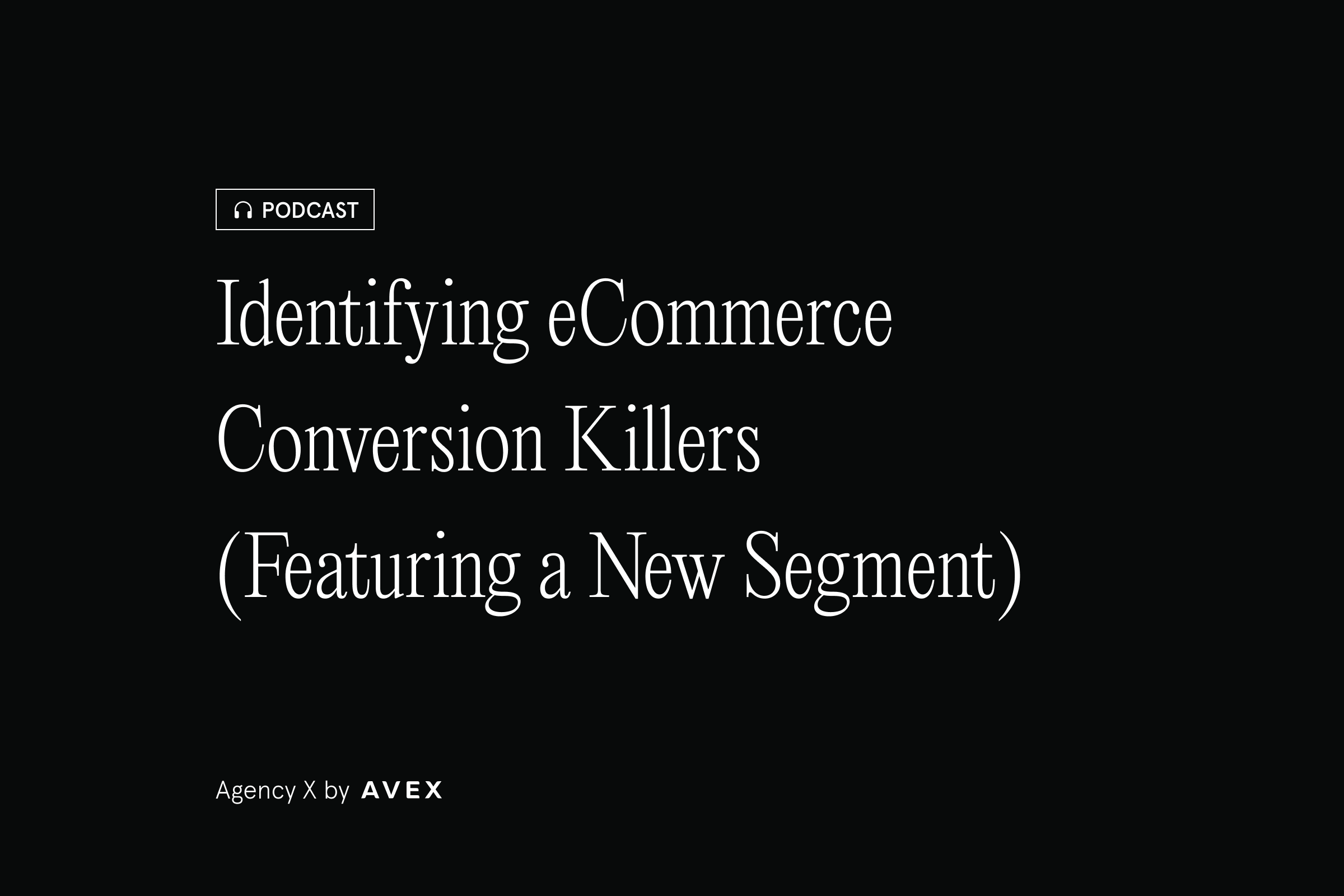Agency X Podcast: Identifying eCommerce Conversion Killers (Featuring a New Segment)

Quick Summary John and David cover recent eCommerce news like Shopify markets and Figs going public, and then provide insights on how to increase conversion rate by improving page speed, testing, and personalization techniques.
John and David have added a brand-new segment to the podcast called "This Week in eCommerce," where they give a quick rundown on current events in the industry and some updates on the brands Avex works with.
This episode's segment includes information about Shopify Markets, Avalara's new Cross-Border Solution, and Pinterest Live Shopping. They also mention a recent case study published for Enjoy Life and our official partnership with Shogun Frontend.
For the bulk of the episode, they give concrete ways to figure out why your conversion rate isn't as high as you expected. Continue reading for tips and tools to increase conversions on your eCommerce site, or listen to the audio.
This Week in eCommerce
Shopify Markets
John 01:18 - 2:13 So back in September, Shopify announced a global eCommerce hub for merchants. And they also added b2b features to Shopify Plus, so they're making more of a push towards larger merchants.
With Shopify markets, it attempts to alleviate difficulties merchants face with cross border commerce, things like language barriers and local regulations, as well as currencies and things like that, that used to require maybe two stores to be able to, or Shopify Plus, to be able to accomplish.
It's really great that they're rolling out this functionality. This initiative is in line with Shopify and shifts towards supporting larger merchants. This is similar to their partnerships with Oracle and Microsoft, as far as ERP integrations go.
Cross-Border from Avalara
John 2:31 - 3:40 What it does is it integrates with Shopify markets, or perhaps it's going to be integrated or come natively with Shopify markets, and they'll be able to calculate the appropriate duty and import taxes at checkout without requiring tariff codes. This is something that sounds really boring, but it's probably something that is a pain in the bud for merchants who are trying to go international.
The feature uses Avalara as an artificial intelligence engine and global compliance content database to generate landed cost pricing, determinating duty, and import tax requirements for more than 180 countries.
It sounds like it's gonna save merchants a lot of headaches and time, which in turn can save us a lot of headaches and time. Avalara says that it provides customers with landed cost estimates in the cart in real time to reduce unexpected costs and costs at delivery. That sounds awesome because it's going to save merchants some money too.
Pinterest TV
John 4:04 - 4:57 With Pinterest, TV creators can showcase and tag products to let users purchase them on the merchants website, which sounds really awesome. They're going to have episodes air each weekday and will be recorded and available for users to watch on-demand.
To me, what this says is this really is one of the early indicators for live shopping, social commerce, things that a lot of people been talking about, but not necessarily doing it right. It is a small but important step towards that. Social Commerce and live commerce is really big in China – and I've been talking about this for a while – they're light years ahead of us when it comes to this channel, amongst other things, but it's very popular out there. I can imagine live shopping, social commerce, all of those things becoming more and more popular here in the States.
Shopify Brands Going Public
John 5:09 - 6:15 Three really notable brands that started and grew on Shopify either went public or announced public offerings. Figs, who sell scrubs and clothing for doctors and nurses, dentists and whatnot, just recently went public.
Allbirds recently went public who's been on Shopify forever and is probably one of the most notable Shopify Plus brands. They’ve seen some tremendous growth, and are now a publicly-traded company, which is huge.
I don't think they're public yet, but they announced an IPO through an SPAC: Black Rifle Coffee, which I'm a big fan of. I've seen them grow up on Shopify as well.
So it just seems like a lot of brands are just getting bigger and bigger. That leads to the question when a lot of merchants ask us, is Shopify going to be able to scale with us? Well, if you want to grow to be a publicly-traded company, worth billions of dollars, then yeah, Shopify could probably scale with you.
Avex Announcements
Enjoy Life Launch
John: 8:18 - 9:05 Enjoy life, which is a Mondelez brand and a brand that I've been a huge fan of for years, we've recently launched their Klaviyo email marketing campaigns, optimizing their flows, as well as refresh their Shopify Plus store with their new branding, which was really exciting to work with them and launch that.
We're continuing to work with them to optimize their site for conversions. And I recently spoke to the head of marketing or the VP of marketing as well as the other another person that from Enjoy Life that we've been dealing with. And I believe they're going to come on the podcast and do an interview about growing the brand marketing, DTC, CPG and all that. So that's really interesting and something I'm looking forward to.
Dynamic Yield Webinar
John 9:07 - 9:53 Our Director of Client Services, Veronica, recently appeared on a Dynamic Yield webinar to talk about personalization, especially when it comes to CRO and testing and things like that for the holidays. So make sure to check that out. It already aired, but it's pre-recorded, so you can check it out.
We've been really growing our Dynamic Yield partnership, a lot of really great brands that we're bringing onto the platform and working to personalize their customer experiences, test them, optimize them and help them increase conversion. It’s a really great tool. We also recently spoke to Dynamic Yield about them coming on to talk about these things. So we should have someone from DY coming on as a guest.
Shogun Frontend Partnership
John 9:54 - 10:29 We've been working with Shogun for quite a while, but we have an official partnership with them, especially with their frontend product. Really exciting things coming out with that product when it comes to headless by making headless easier. So I think that there's a unique place for Shogun, given their vast experience with their page builder tool and all the different brands that are on it.
Looking forward to some of the things that come out of that partnership, we already have one Shogun front and build under our belt with OneBlade Shave. That case study is live on our website, if you want to check it out.
How to Identify Conversion Rate Killers
Landing Traffic
David 11:42 - 13:25 For the most part, we focus on looking at landing page traffic when it comes to the homepage, collection pages, the groups of pages, and then PDPs. Because that is where 70 to 80/90% of traffic is going to land. Otherwise, it'll either be special landing pages, it might be like the cart or checkout, if a user is trying to reconvert, but for the most part, it's those three page types: home collection, and PDP.
We look at is traffic distribution based on revenue distribution for those users. So let's say for example, on collection pages, collection pages are responsible for 10% of landing page traffic, which is low, but they're generating 5% of overall revenue. That's normal, that's something that we look at. The reason why revenue percentage is so low is because they're not driving a lot of traffic there, which to be honest, is probably appropriate for a collection page. Because for the most part, we tend to see the lowest conversions on a collection page outside of very specific instances, like restocks, or new drops, that kind of thing, depending on the industry you're in.
But if we see, and I've seen this a couple of times with a couple of our clients where, landing page traffic to PDPs is as high as 50, or 60%. But revenue percentage from those users is something like 13 to 15%. That shows a potential issue, because you're sending a lot of traffic to pages that are not converting well. That's going to contribute to a low conversion rate.
Are you seeing 30% of revenue from Email & SMS Marketing? Let's Discuss.
Page Speed
John 15:39 - 17:33 Another thing is testing for PageSpeed. Now, this is something that, you know, Shopify does in the dashboard, or if you run it through some tests, they're not entirely accurate. For better or worse yet, they're not entirely accurate, but you need to be doing certain things. Grab the low-hanging fruit, and make sure you're doing these regardless of what that PageSpeed score is.
So evaluate your content and optimize it, look at what you're doing, are you saving PNGs and uploading super high-res files that need to be compressed, and you're uploading the largest file possible, save it out in Photoshop, or whatever other tools, minimize it, compress it, optimize all of your content, have a process for when you're adding products, when you're adding content to the homepage, or blog posts or whatever it is, make sure you're optimizing that content.
Be mindful of where you run tests, because as David said, it can be tricky. And take that with a grain of salt. Then have your developers minimize code, look at JavaScript. If you are a high-growth brand, maybe you're doing $5, $10 million plus, at a minimum, you might want to explore headless because this is where that PageSpeed optimization is going to come in. That's absolutely going to help with conversions.
But even for brands that are doing $20 to $50 million, headless might not be the right approach for you. There are plenty of brands that are doing 10s of millions or hundreds of millions that are not headless, you have to have the infrastructure to support it, it shouldn't only be to have a fast site or a high converting site has to you have to understand what comes along with headless. But those are some things you need to do when looking at PageSpeed make sure that your code your site is coded properly, minimizing things removing code bloat, and extra JavaScript and things like that, and optimizing your content.
Segmentation and Personalization
John 22:20 - 23:53 I'm a huge fan of segmenting. My mind is blown when I see brands who are doing $5, $10, $15, $20 million in revenue and aren't segmenting. They're not personalizing or A/B testing, not only on site, but through email. Through email, you're leaving millions of dollars on the table, because there's so much that could be tested and optimized and personalized and segmented, where you're providing a more curated experience.
A lot of brands, they may say, Oh, we want to elevate our experience, we want to provide a better customer experience. And they really think that's just around like UX design or like the look and feel of their site. But if you're a brand that's selling men's and women's in various different categories, and you're not segmenting, if you're not personalizing (of course, if you're a smaller brand, and you can't afford to do it, there are affordable ways to do it, there affordable ways if you know what you're doing) but if you're brand new, and $5+ million, and you're not taking advantage of that, especially in email, not only on site segmenting, but email, being able to segment your customers very detailed, not just hey, this is men's and this is women's, it should be really detailed based off of customer actions. Serving them content, you need to get granular with that, because that's the way brands start to scale and grow and really start to get the edge.
Best Practices for eCommerce Brands
David 24:21 - 25:48 Smaller brands tend to have these issues where there's absence of what we call best practices on a website. A good example is a sticky navigation menu. That's where when you scroll down the page, the navigation sticks to the top of the screen. I'm sure we've all been on websites that do that, most even kind of do that now. But, when you're looking through a site, you've gone through your due diligence of looking at their analytics and where people are going, seeing where the gaps are, and you're attempting to identify, are there some missing best practices or features on your website that might be really important to have.
That could be anything like having like what I described before, a sticky navigation menu, having a call out for shipping and returns details on your PDPs because that's a really important aspect for your website, or even an absence of a free shipping promotion, if your brand doesn't do free shipping. Operationally, if you're able to support that in some means, it's really important to implement.
But, and something we've been getting a lot better at doing, I think a really strong point about Growth X in addition to Managed Services, which is more of a traditional design/dev relationship, is that whenever we recommend best practices, like the ones I just described, we can actually test them and make sure that they are contributing positively to the user experience.
Utilizing Customer Support Tickets
John 29:29 - 30:33 Look at your customer support tickets that are coming in. There are ways to search through them. There are ways to segment them/to have automation there, or even talk to your customer support team and figure out what's the most common thing that's coming up and start a list of things that keep coming up repetitively, and then test those things to see where there can be improvement.
David, like you just said, even if there's a problem, you don't necessarily know exactly what the solution is unless you test it. So you may want to try a few different things. And it's a very cost-effective way that could have a high impact because if it ends up increasing your conversion rate by a percentage point or increases your average order value by X percent, that can be hundreds of thousands or millions of dollars, even if it's only 10s of 1000s of dollars, depending on the size of your brand, it can be very much well worth that investment of time to just go the extra mile.
David 31:35 - 32:08 Magic spoon, when they started offering bundles, like build your own bundle, they only knew that because half of the comments they'd get on their Instagram posts were Hey, is there is it possible for us to make custom bundles instead of these pre-made ones?
Their customer service team is really great at finding and validating. Overall, those are all really important things that you need to do. And if you're a smaller brand, smaller brands are gonna want to test more of the UX of their website, or as larger brands can really dive into personalization and segmentation.
Conclusion
John 32:58 - 33:46 Like you said before, sometimes even the best studies and the best practices based off of data, you have to test it with your customers and even get real feedback from your customers because even if it helps a small percentage of your customers, it might still be very impactful to the bottom line. If your goal is to provide a great customer experience, not to make sure that you're providing that to everyone across the board.
Alright, so I think we had some really good tips there ways that you can identify these conversion killers – PageSpeed testing, best practices looking at analytics. If you have any questions, feel free to reach out to us. And we have some more CRO topics coming up on upcoming podcasts.



